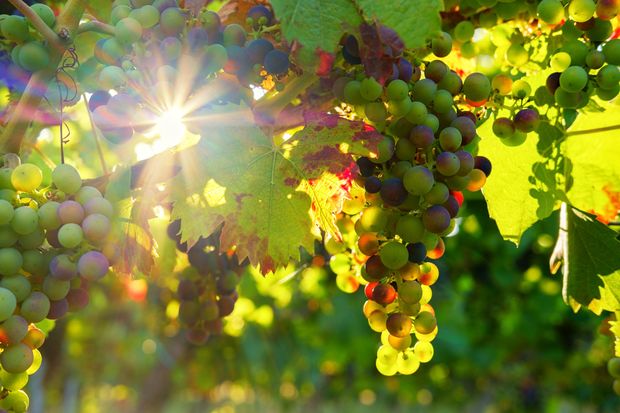Congratulations on your valor!
You have committed yourself to doing battle against a formidable (though, not unconquerable) opponent. The WSET Level 3 wine exam covers a formidable body of information. It will require many, many weeks, and even months of dedicated studying to suit up with the wine facts necessary to vanquish this opponent.
But if knowledge is your weapon, Brainscape is the sage master swordsman who will equip you with the cunning, strength, and dexterity to wield your weapon like the great Trojan, Achilles (minus the silly incident with the heel).
What you have in your hands right now is Brainscape’s ultimate guide on what to expect on the WSET Level 3 exam. In this guide, we’ll take a close look at what topics are covered in the WSET 3, and how you can best approach studying so that you cover everything in good time and crush this prestigious wine exam.
What you’ll learn in this WSET Level 3 overview:
- 4 Important study tips for the WSET 3 exam
- Exam topics in the WSET Level 3 wine exam
- WSET 3 exam format and what to expect
- Using Brainscape to vanquish the WSET Level 3 exam
Let’s get to it!
Pssst! Check out our article 'How to answer WSET short-answer questions' to learn the best strategy of attack for this notoriously tricky section.
4 Important study tips for the WSET 3 exam
Before we dive into the content and what's in the WSET 3 exam, there are a few important tips you need to know about the nature of the beast you intend to face. Knowing these will arm you with greater respect for your challenger, and help prepare you for action ...
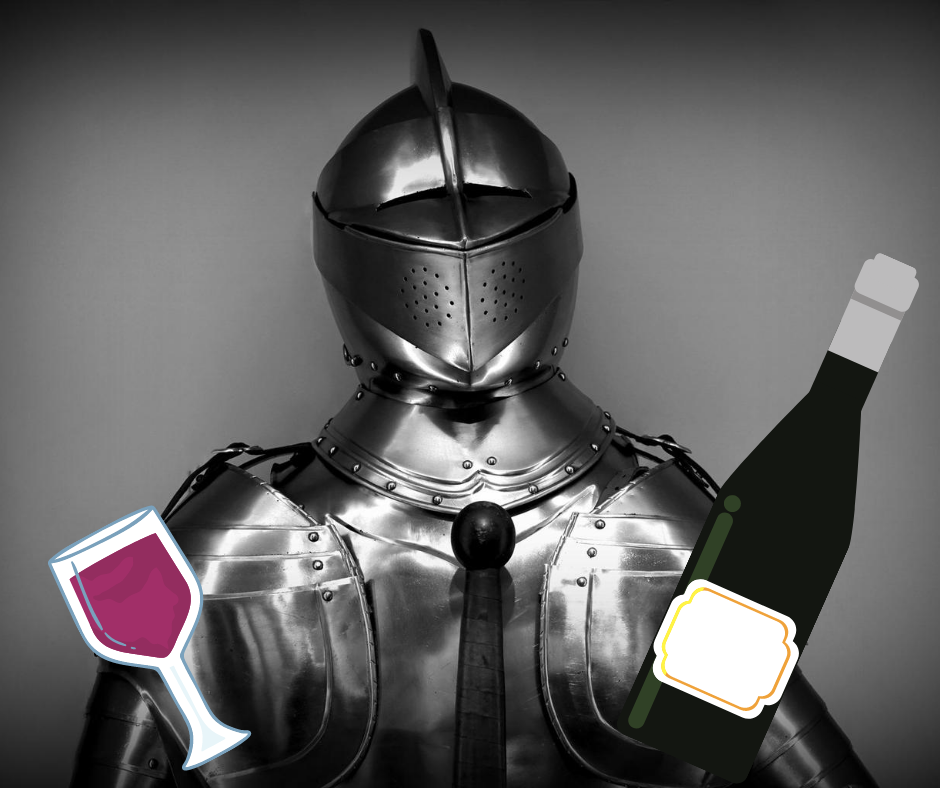
Tip 1: The WSET Level 3 is A LOT harder than Level 2
Half of all the students who sit for the WSET Level 3 exam, worldwide, FAIL because they simply don’t plan their time wisely enough. As a result, they aren’t able to study everything in time, which leads to cramming, anxiety, failure, and very likely several bottles of wine to wash away the bitter taste of defeat.
The message here is: don’t judge the WSET 3 based on the scope or the amount of studying you did for the WSET Level 2 wine exam. That was yesterday’s challenge, met and vanquished. Now, you are majorly “leveling up” by tackling the WSET 3, which is even more demanding and knowledge-intensive than its predecessor.
If timing is your primary concern, check out Brainscape’s ultimate guide on How to study for the WSET 3 more efficiently.
Tip 2: Study throughout the course
The best way to memorize and internalize the mountain of knowledge delivered through the WSET 3 coursework and textbook is to pace your learning over the duration of the course, which is generally between four to five months (16 to 20 weeks). That’s plenty of time to prepare ... if you start on day one:
- Yep ... start studying on day one (literally, on the first day of your course, go home and study what you learned in class). Rinse and repeat.
- Review the relevant textbook chapters before a lecture so that nothing you hear in class is brand new to you (and you’ve had a bit of time to digest it).
- Use lectures to ask questions, focus on your problem areas, and clear up any confusion.
- Use Brainscape’s WSET 3 Flashcards to memorize the facts from each chapter as you progress through them in class.
If you follow these steps, you will arrive at the end of your course fully versed in all the facts and information you need to send the mighty WSET 3 back to Hades from whence it came.
Tip 3: Use Brainscape’s WSET 3 Flashcards
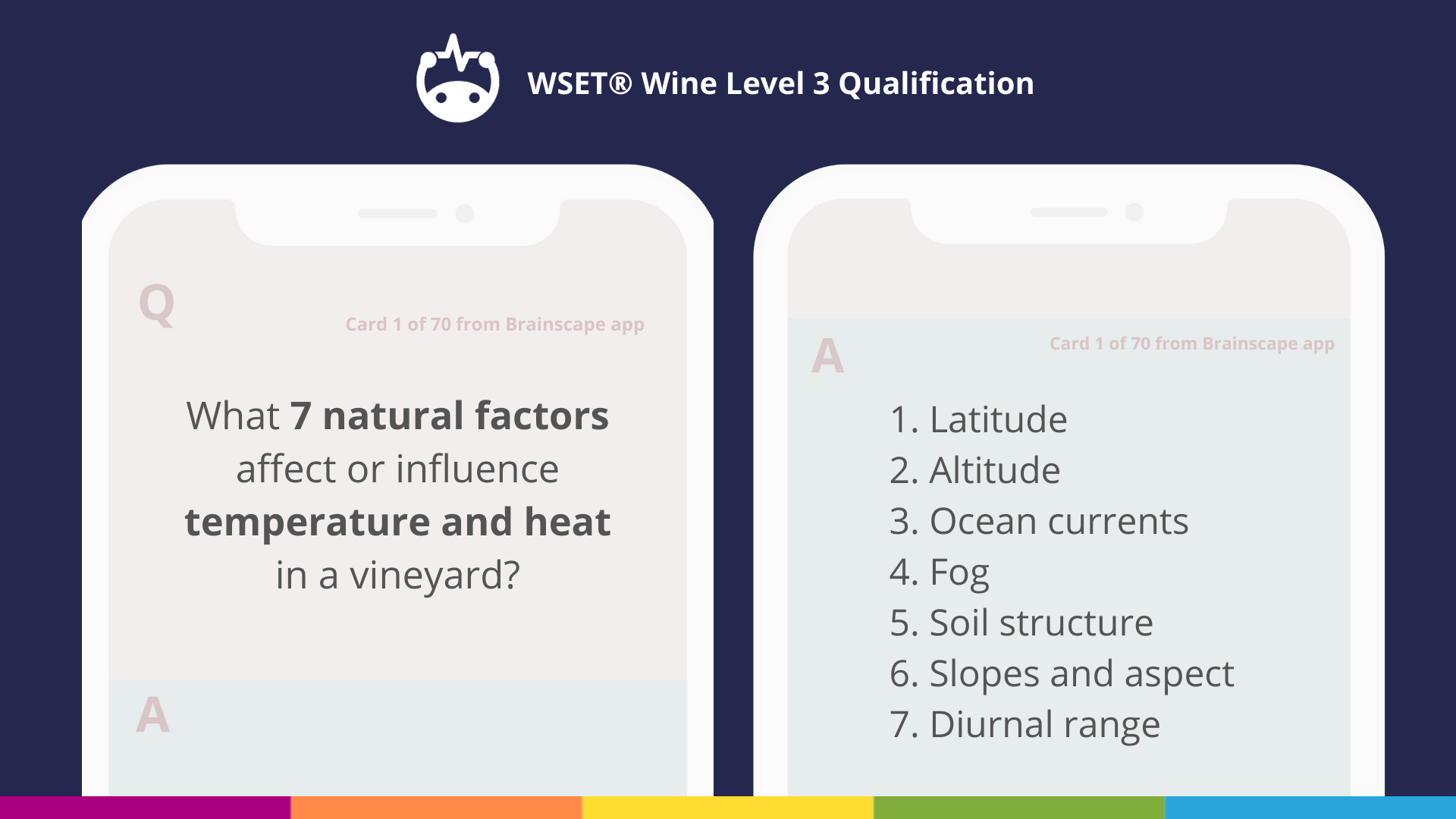
Listen closely because this can mean the difference between falling at the feet of the WSET 3 or triumphing over it (with distinction):
Use Brainscape’s WSET Level 3 Flashcard collection to memorize and internalize the hoards of facts and information needed to pass the exam. Seriously, based on decades of cognitive learning science, this savvy flashcard learning app is your secret weapon for passing the WSET 3. And here’s why:
Brainscape is a proven effective tool for studying knowledge-intensive subjects like WSET Level 3. In fact, we have tens of thousands of active users preparing to do battle with equally formidable foes like the bar (yes, The Bar) and MCAT (medical school entrance) exams.
In other words, Brainscape is a serious weapon for serious learners!
The super engaging web and mobile learning app:
- Breaks knowledge down into logical bite-sized pieces, which it poses in simple question-and-answer flashcard pairs.
- Compels you to study using active recall and metacognition, two cognitive learning principles that are proven to help you learn by forming deeper, more permanent memories of the information you’re studying.
- Focuses on your weaknesses and saves time on unnecessary study through the spaced repetition of information you aren’t confident in.
- Enables you to study anywhere, anytime in those little breaks you find yourself with throughout the day, which add up. You can effectively sneak in upwards of an hour of study time during your daily commute, while waiting for class, on the treadmill, etc. And this is so important when you consider just how much material the WSET Level 3 covers.
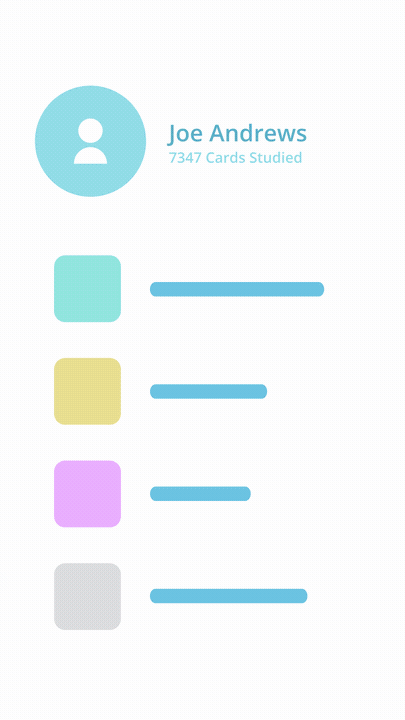
Still dubious? Read about the sexy cognitive science behind Brainscape.
“The way Brainscape’s flashcards reinforce what you learn through spaced repetition is what helped me pass with distinction,” says Sarah Looper, the New York-based wine educator who led the team of certified experts we worked with to put together this guide and our masterful WSET 2 and WSET 3 flashcard collections.
Tip 4: Review, review, review!
When you’re not onboarding new facts, you need to be reviewing the stuff you learned in earlier lectures. The more frequently you expose yourself to this information, the more permanent your memories of it will become.
In case you didn’t get the message earlier: the WSET Level 3 is a monster of an examination and the only way to victory is hard work, consistent (opportunistic) studying, and relentless review, review, review!
Exam topics in the WSET Level 3 wine exam
With this reality check out of the way, let’s now dive into what exam topics you can expect in the WSET Level 3. What follows are 12 overarching sections, beneath which we’ve provided a sort of checklist of “what you need to know” facts. Make sure you know and understand them, and how they relate to each other!
Topics in the WSET 3 exam: an outline
- Tasting & evaluating wine
- Food & wine pairing principles
- Storage & service
- The anatomy of a grapevine
- The environment for grape growing
- Vineyard management
- Winemaking and maturation for still wines
- Factors that affect the price of wine
- Wine and law
- Winemaking countries and their regions
- Sparkling wines
- Fortified wines
1. Tasting & evaluating wine
View Brainscape’s WSET 3 flashcard deck on the ‘Systematic Approach to Tasting’.
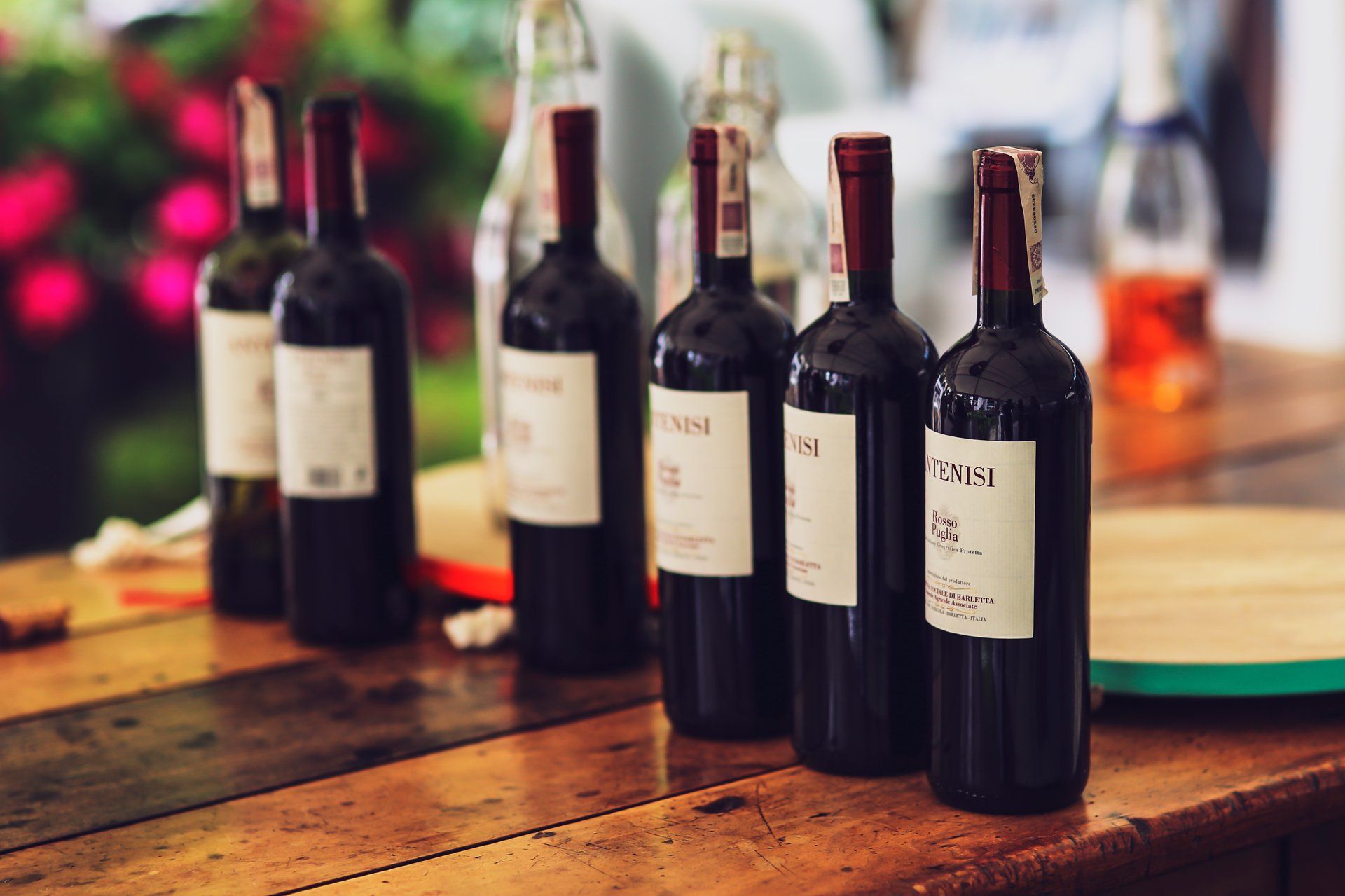
The practical component of the WSET Level 3 wine exam will require you to be intimately acquainted with the wine tasting ceremony:
- The best environments for a wine tasting and their features (e.g. odor-free, availability of spittoons, good natural lighting, etc.).
- The right personal preparation for a wine tasting (e.g. don’t wear scented lotions or perfumes and don’t brush your teeth right before you taste wine, etc.).
- The perfect pouring size, which is 5cL or 1.7 fl. oz.
Then, you’ll need to be comfortable and familiar with the WSET Systematic Approach to Tasting ® (SAT), the methodology for developing the fundamental observational skills for tasting and evaluating wine. You should not only be able to define the SAT but also follow its algorithm in your identification of wines in the practical exam.
Your knowledge checklist for tasting and evaluating wines include knowing:
Color intensity and terminology
The difference between ‘pale’ and ‘deep’ (and how to describe them) and the various color descriptors for white wines (lemon-green, lemon, gold, amber, and brown); red wines (purple, ruby, garnet, tawny, and brown); and rosé wines (pink, salmon, and orange).
Aroma intensity and terminology
The different aroma intensity options (light, medium, and pronounced) and the differences between primary, secondary, and tertiary aromas with examples of each for both red and white wines.
Sugar, acid, tannins, alcohol
The intricate dance between sugar, acid, tannin, and alcohol really determines the quality of a wine and your ability to enjoy it. So, for this section, you’ll need to know:
- Sugar: The difference between dry, off-dry, medium, sweet, and luscious descriptors for a wine’s sweetness.
- Acidity and tannin: What these elements taste and feel like on your palate, and the difference between the low, medium-minus, medium, medium-plus, and high descriptors.
- Alcohol: Contributes to texture and body and, at higher levels, can make a wine feel heavier on the palate. Alcohol can also trigger pain sensors or tingly sensations, which many people confuse with acidity. You’ll also need to know the alcoholic ranges for light, medium, and full-bodied wines.
- Mousse: Be able to discern between sparkling wines with delicate, creamy, and aggressive bubbles.
- Readiness for drinking: Evaluate whether a wine is too young to drink; if it can be enjoyed now but has potential for aging; if it should be drunk now because it’s NOT suitable for aging or it’s peaking; or, if it’s too old.
Quality levels
Know the five quality levels of a wine (outstanding, very good, good, acceptable, poor) and be prepared to give reasoning as to WHY you assessed as you did, discussing the wine’s balance, length, complexity, and intensity of flavor and aroma, etc.
You should also be able to:
- Articulate what makes wines different at the Grand Cru, Premier Cru, and Village levels.
- Identify faults and their trademark aromas, for example TCA, reductiveness, sulfur dioxide, oxidation, out of condition, volatile acidity, etc.
2. Food & wine pairing principles
View Brainscape’s ‘Wine with food’ flashcards for the WSET 3.

Have you ever enjoyed a gorgeous Cabernet Sauvignon that paired beautifully with your rich, meaty dinner, only to have it turn your face inside-out with dessert? The flavor profiles of the food you eat greatly affect the taste of the wine, which is why food and wine pairing is so important.
But you probably know this very well by now.
For the WSET Level 3 exam, you’ll need to know how each of the six taste sensations in food (sweet, salt, acid (sour), bitterness, umami, and heat from spice) affects the taste of the wine being paired with the food, and vice versa.
You should also know which of the primary flavors are considered “high risk”, i.e. they easily affect (for better or for worse) the flavor of the wine (sugar, umami, bitterness, and heat). And, similarly, which of the primary flavors are “low risk” and do not easily affect the flavor of the wine (salt and acid).
Conversely, know how to define high-risk wines, which can overpower or clash with the flavor of the food; and low-risk wines, which are versatile and tend to pair harmoniously with most dishes.
Pro Tip: Use Brainscape to study this section! All of these important exam topics in the WSET 3 are arranged neatly into question-and-answer pairs in Brainscape’s WSET 3 flashcard deck on ‘Wine with food’, which facilitates the efficient and smooth learning of this essential area of study.
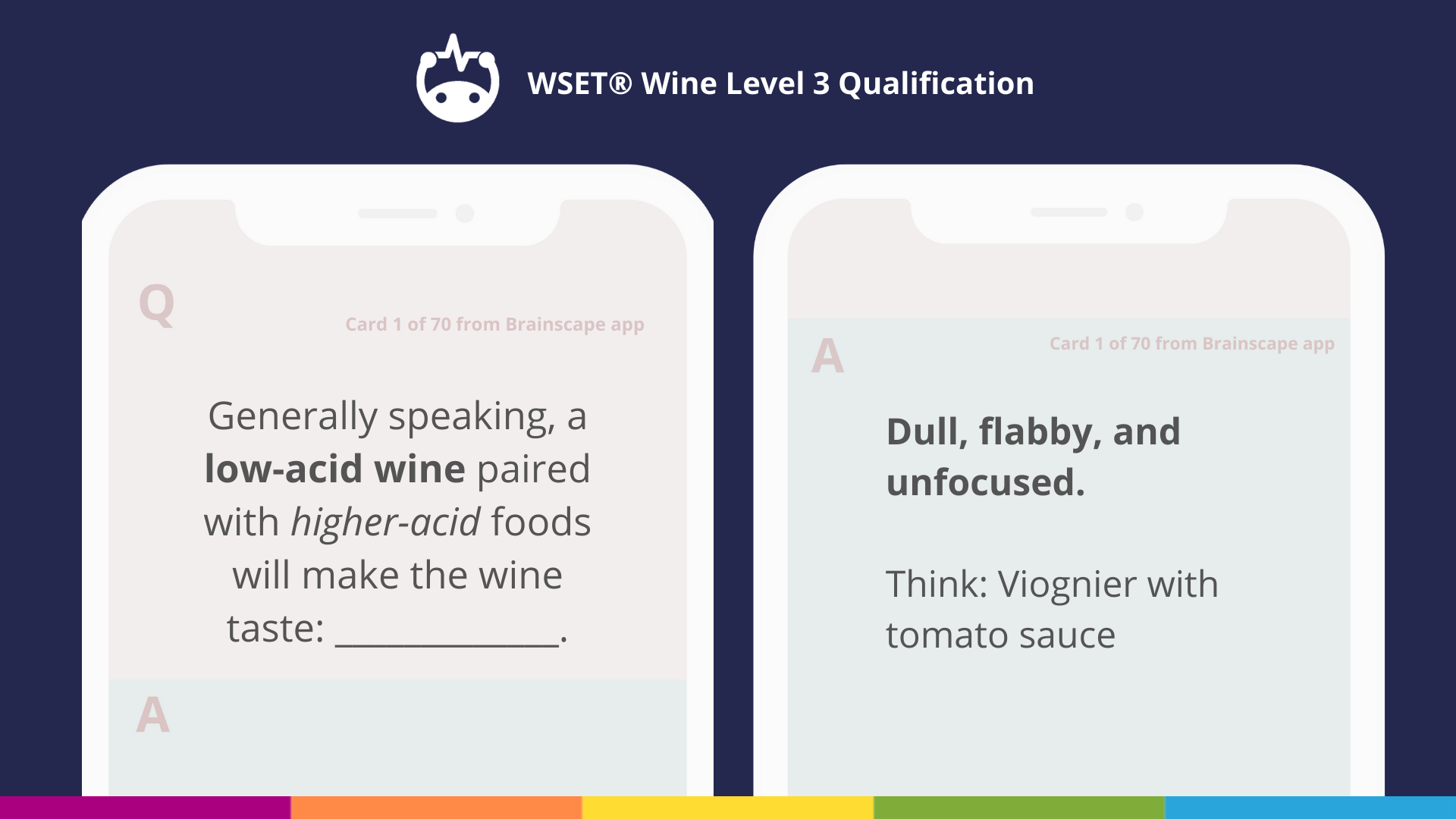
3. Storage & service
View Brainscape’s ‘Storage and Service’ flashcards for the WSET 3.

The WSET Level 3 exam will expect you to know:
- The proper storage conditions for different wines.
- The optimal serving temperatures for different wines.
- How to open a bottle of still or sparkling wine, and how to decant a bottle.
- How many pours (and the size of those pours) you get out of a bottle.
- How to preserve wine after it’s opened.
4. The anatomy of a grapevine
View Brainscape’s ‘Viticulture’ flashcards for the WSET 3.
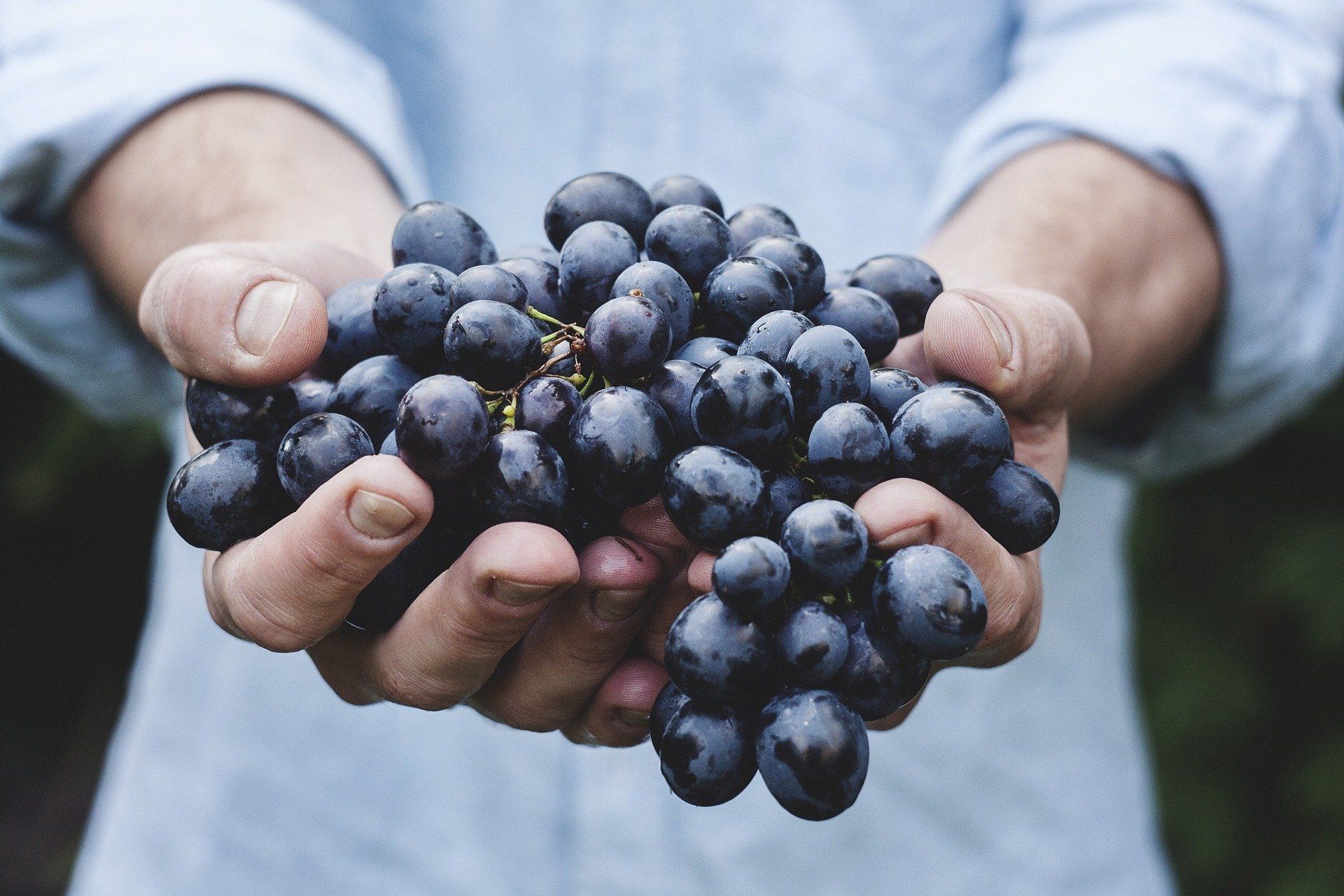
Grapes are the building blocks of wine so as a WSET Level 3 candidate, you are required to deeply understand the biology of the grapevine, from its annual cycle (in both hemispheres) to the organic chemistry of its fruit. You’ll also need to be well-versed in the various aspects of viticulture that are leveraged to grow the best quality vines, as well as the challenges that can beset a vineyard:
- Crossings, hybrids, and rootstocks (and the differences between them).
- Phylloxera, what it is, what it does, and how to control it.
- Grafting, what it is, and how it’s done.
5. The environment for grape growing
View Brainscape’s ‘Climate’ flashcards for the WSET 3.
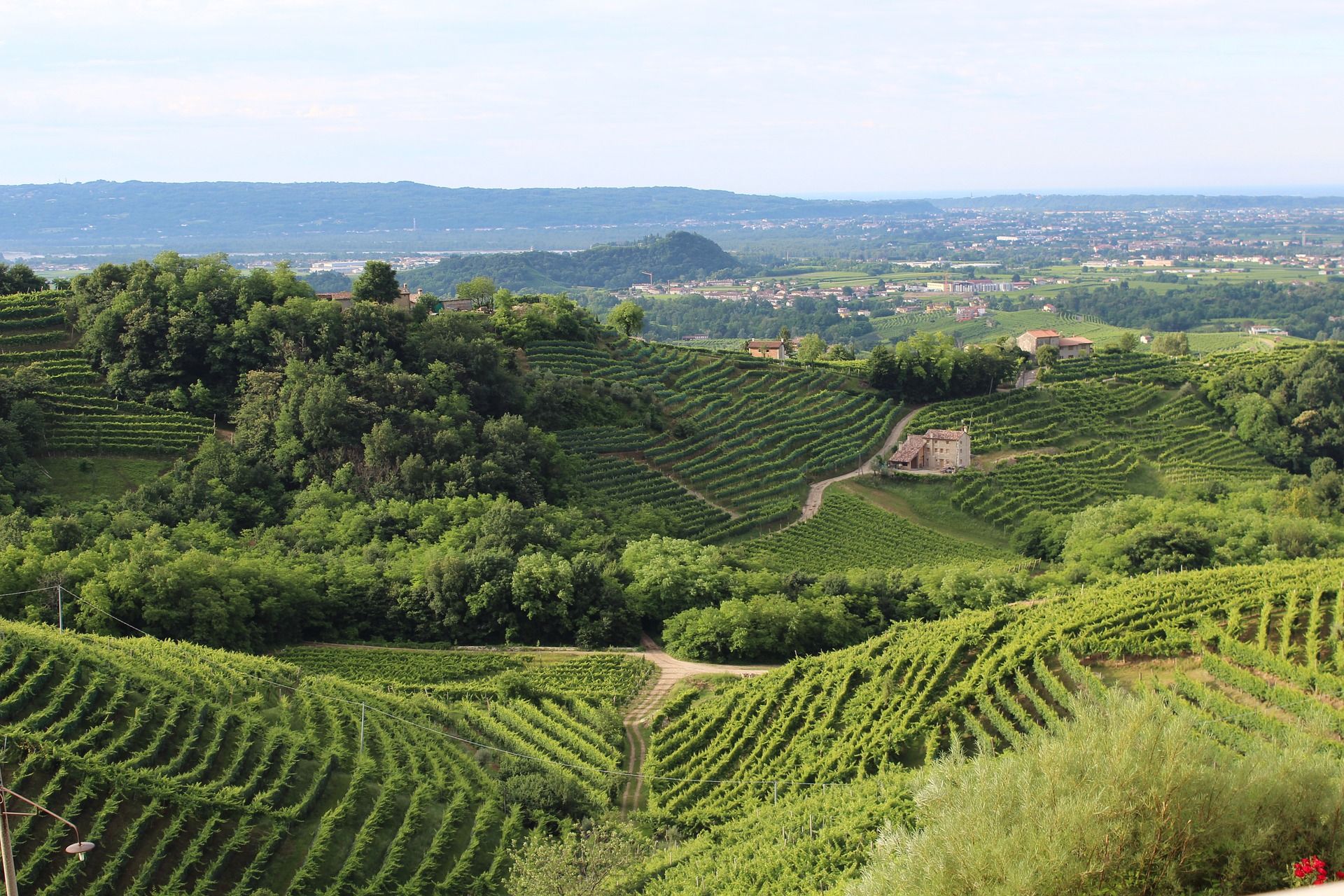
Ah, terroir! The gentle interplay of climate, geography, weather, aspect, and soil plays such a fundamental role in wine-making that to give it any less than 100% of your undivided love and devotion is to handicap yourself in going up against the WSET Level 3.
For this section, you need to have an intimate understanding of what a vine needs to grow and the various factors that can help or harm them, for example, heat, sunlight, carbon dioxide, water, nutrients, etc. Breaking this down further, you need to know:
- The climatic and geographic factors that affect how warm or cool a region is (think: latitude, elevation above sea level, location of nearby warm or cold ocean currents, frequent fog, the aspect of the vineyard, etc.).
- The climate classifications (cool, moderate, warm, hot, continental, maritime, etc.) and their features.
- The features of continentality and how diurnal ranges in temperature can affect the vine.
- The kinds of temperature hazards a region might experience in winter and spring, and how to combat them in the vineyard.
- The different irrigation techniques.
- Know your soils and how factors such as drainage, water retention, composition, and types affect viticulture.
Brainscape’s WSET 3 flashcard decks on climate and the 27 individual regional decks (from Alsace to New Zealand) cover all the facts you need to know to ace this portion of the exam.
6. Vineyard management
View Brainscape’s ‘Viticulture’ flashcards for the WSET 3.
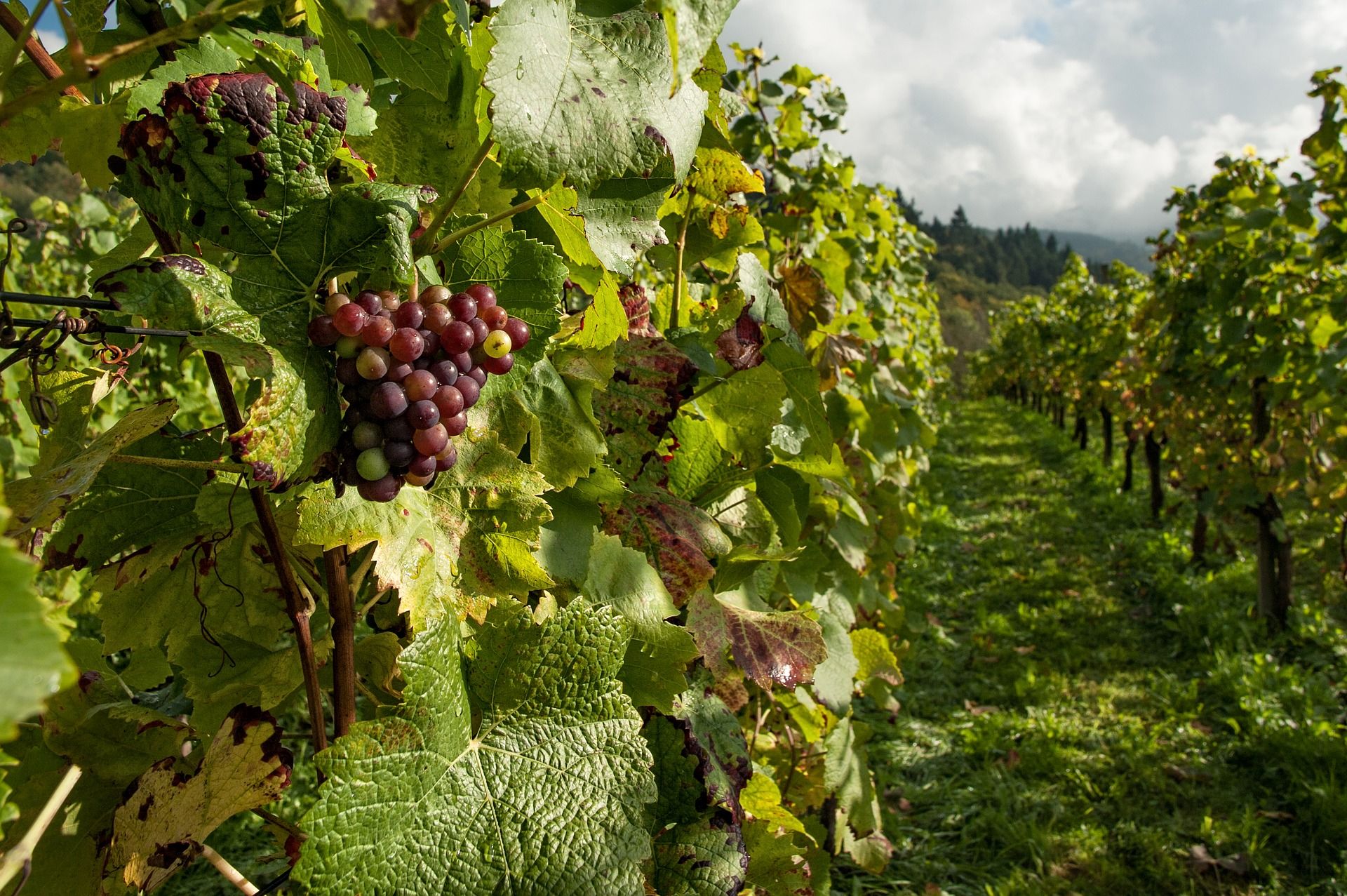
With all the theory of the afore-discussed section under your belt, you can now imagine yourself as a grape farmer looking to establish and manage the most glorious vineyard. Here are the elements you can expect to be tested on in the WSET Level 3:
- Vineyard site
The considerations that go into picking a site to plant a vineyard. - Training
The three different types of training (head-trained, cordon-trained, or untrellised) and which climates each works best in and why, taking into consideration heat, drought, and precipitation (rainfall, fog, mist, etc. - Pruning
The two types of pruning (spur and replacement cane pruned). WSET 3 students confuse these all the time so be clear on what they look like and which climates they work best in and why. - Canopy management
What the canopy is and how to work it so that the vine produces the best quality / quantity grapes (depending on your goals as a viticulturist). - Planting density and yield
Know what plant density is and how it affects competition for water and nutrients between the individual vines planted in a vineyard. Also, know what yield is and the relationship between yield and quality (i.e. quantity versus quality). - Pests and diseases
A fundamental part of managing a vineyard will be dealing with unwanted visitors, from bacteria to birds. For the WSET Level 3 wine exam, you will need to know about all the different pests, what they are, how they spread, and how you can control them. Be clear on the difference between fungal, viral, and bacterial diseases and the methods for treating them. - Sustainable, organic, and biodynamic viticulture
Welcome to agriculture in the 21st Century! Be able to identify the differences between sustainable, organic, and biodynamic viticulture. - Harvest
Familiarize yourself with how, why, and when grapes are harvested.
7. Winemaking and maturation for still wines
View Brainscape’s flashcards on the ‘Vinification of White Wines’ and the ‘Vinification of Red and Rosé wines’.
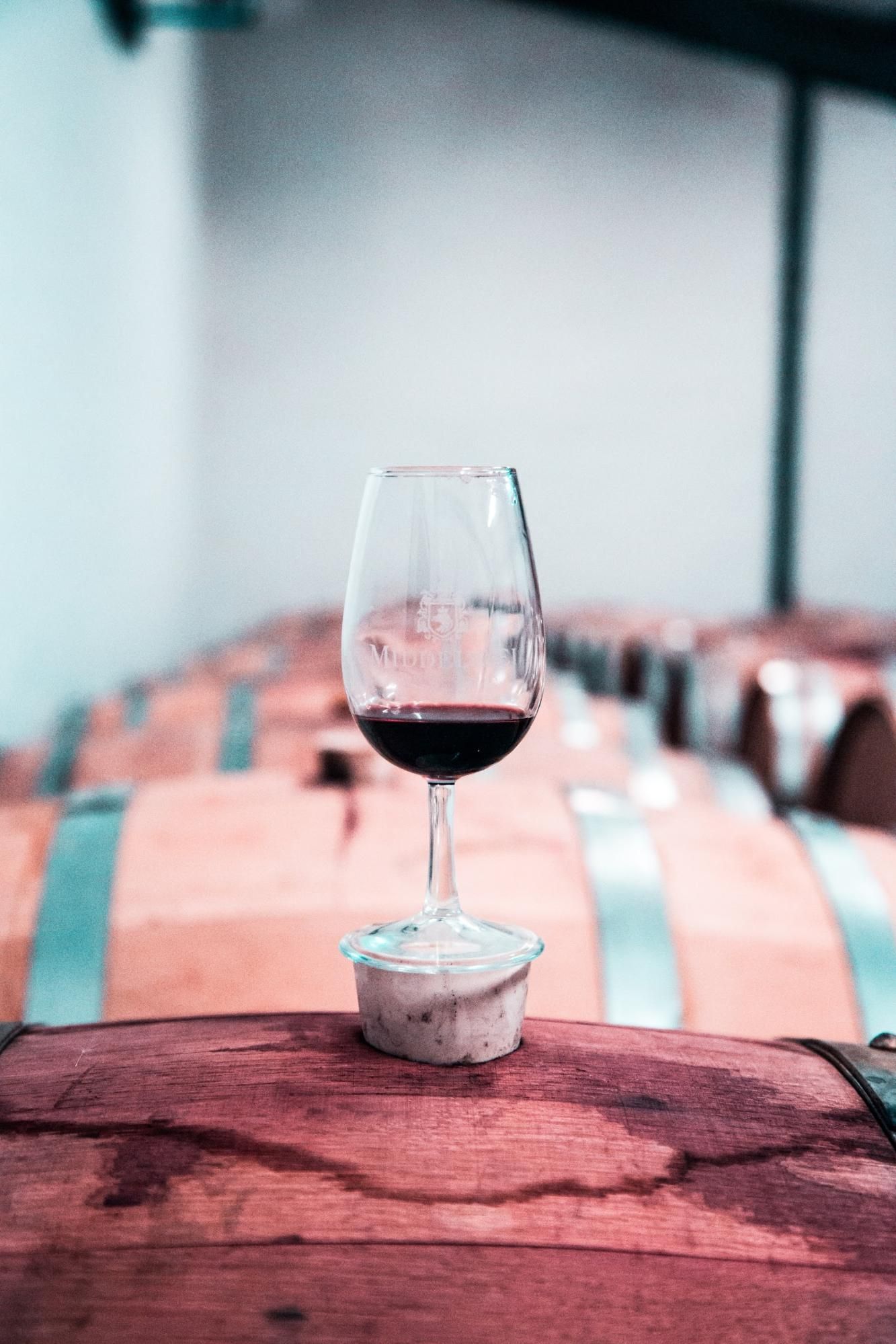
At this point, you will likely know enough to buy your own plot of land, plant some grapevines, and grow quality fruit. But now we’re getting to the real biblical stuff: turning grape juice into wine! Here are the winemaking exam topics tested in the WSET Level 3:
Topic 1: Grape sorting and processing
How grapes are processed and the individual phases of processing for white, red, and rosé wines, as well as any necessary adjustments that need to be made.
Topic 2: Fermentation and filtering
Fermentation is an essential step in winemaking so know the different kinds—(1) primary (alcoholic) fermentation and (2) secondary (malolactic) fermentation—what initiates both, and the effects they have on the taste and presentation of the wine.
Also know what the lees are (dead yeast cells), how they influence the wine, and how to filter them out once the wine is ready. And then, of course, know how filter and fining is done and in what context/when either may be required.
Finally, you should know how to stabilize a wine for tartrates, microbes, and oxygen, which is something usually done before bottling, after primary and secondary fermentation (if relevant) takes place.
Topic 3: Oxygen and sulfur dioxide in winemaking and maturation
The role oxygen plays during winemaking and maturation and what sulfur dioxide does, when it’s deployed, and why.
Topic 4: Know your vessels
Wine is fermented and aged in large vessels, which can be made from a suite of materials. You’ll need to know:
- The different species of oak that are used to make barrels and the various sizes of oak barrels (their origin and effect on wine).
- The alternatives to oak (inert/inox/stainless steel and concrete) and their effects on the wine.
Topic 5: WHITE wine-making methodology
The WSET Level 3 will test your understanding of the methodology of white wine making, from the vineyards to the cellars:
- The aromatic, semi-aromatic, and neutral grape varieties and which wine-making styles are best for each
- Stylistic options (skin contact, clarification, stabilization, malolactic fermentation)
- Fermentation temperatures (Americans, learn your temperatures in degrees Celsius!)
- The difference between inexpensive, high volume wines and premium wines
- How to make sweet white wines (icewine, Botrytis, süssreserve)
- Packaging and enclosure options
For flashcards on the vinification of white wine, check out Brainscape’s awesome WSET level 3 collection!
Topic 6: ROSÉ and RED wine-making methodology
The same goes for red and rosé wine making:
- How rosés are made (direct press, skin contact, blended with white wine).
- Keeping stems vs. destemming vs. whole bunch (carbonic maceration)
- Fermentation temperatures
- Cap management
- Punch downs vs. pump overs
- Maturation options
- Packaging and enclosure options
8. Factors that affect the price of wine
View Brainscape’s flashcards on ‘Wine, Law, and Costs’ for the WSET 3.

Know all the variables that go into determining the final price of a bottle of wine, from the price of land, winemaking methods, and vessels used, to packaging, transport, taxes, etc.
Pro Tip: One of the greatest benefits of using Brainscape to study for the WSET Level 3 exam topics is that—being a web and mobile flashcard app—you can take it with you anywhere and everywhere you go. This means that you can sneak quality study time in those 5, 10, 15, and 20-minute breaks you often find yourself with throughout the day.
On the bus ride home, on the treadmill at the gym, in the break between classes, over lunch, or even in the bath at night ... by the end of the day, you can log as much as an hour of additional WSET 3 study time, which is really the key to passing this exam. The world of wine awaits, all you have to do is log into Brainscape …
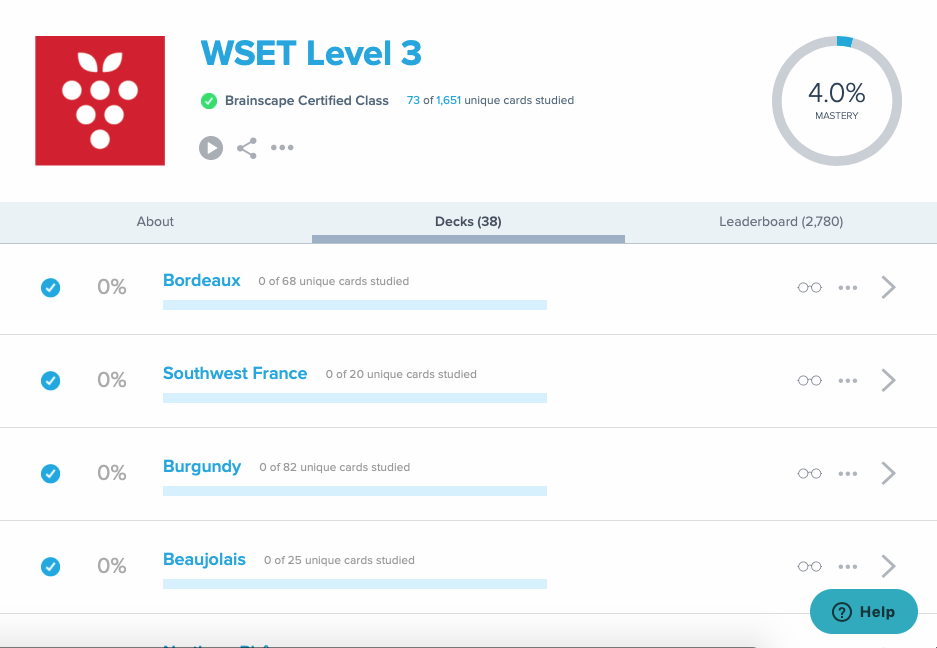
9. Wine, law, and pricing
A Geographical Indication (GI) identifies the wine as originating in a specific region or locality (e.g. Bordeaux, Burgundy, and Champagne) and it tells consumers quite a bit about its pedigree. You’ll need to know how GIs are broken down within each country (for example, in the European Union: PDO/AOP, PGI/IGP) as well as the various consumption laws and what can go on the label.
Check out Brainscape’s deck of ‘Wine, Law, and Costs’ flashcards for the WSET 3 exam.
10. Winemaking countries and their regions
Pack your bags, we’re going on a wine-soaked trip around the world! The WSET Level 3 exam tests your knowledge of the wine-making regions of the world, their laws, most planted grapes, climate, production methods, and more …
- The laws, hierarchies, and classifications within each region (Europe, Canada, The United States, Australia, and South Africa).
- Regional grape varieties and styles: The most-planted grapes in each region for red, white, and sweet wines (if applicable) and if any come in specific styles (e.g. Chenin Blanc in Loire Valley grows best in Vouvray, Savennières, and Coteaux du Layon). Also make sure you’re able to compare and contrast the different grape varieties’ styles in regards to climate and soil (e.g. chardonnay from California vs. chardonnay from Chablis).
- Climate characteristics and weather threats: Each region’s seasonal climate (and how that impacts wine-making) and the various weather threats to viticulture.
- Production and maturation methods: The regions’ production and maturation methods, especially if any are distinctive (e.g. carbonic maturation in Beaujolais).
- Appellations: Examples of the different regions’ top appellations (e.g. Barolo and Barbaresco in Piedmont, Italy) and the styles of wines made there.
- Geography: How a region’s topography (mountains, lakes, ocean, etc.) affects a region and how that expresses itself in the wine (e.g. the Andes’ effect on Mendoza or the “Cape Doctor” southeasterly summer winds in Cape Town, etc.).
- Quality indications: Regional indications of quality and their hierarchy (e.g. prädikat and Grosses Gewächs in Germany).
- Sweet wines: The various levels of sweetness and their hierarchy (e.g. Tokaji Aszú and Tokaji Eszencia in Hungary or VT and SGN in Alsace).
Brainscape’s WSET Level 3 flashcard program contains a deck for every winemaking region you’re required to study for the exam, making it easy and convenient for you to learn the facts.
11. Sparkling wines
View Brainscape’s flashcards on ‘Champagne / Sparkling Wines’ for the WSET 3

Basically, know everything about sparkling wine for the WSET Level 3 exam!
- What the ideal grapes are and why
- How the grapes are harvested
- The production methods
- Autolysis, blending, disgorgement, and bottle maturation
- Sweetness terms and their residual sugar range
- The different styles (non-vintage, vintage, rosé), etc.
Also know the top regions for bottle-fermented and tank method sparkling wines, how they’re made (know each and every step!), and how to tell the difference between the two by appearance, nose, and palate.
Pro Tip: Keep track of your progress with Brainscape! As you study your WSET 3 flashcards on Champagne / Sparkling wine, the app keeps track of your time, reminding you at regular intervals how much study time you have left before you reach 100% mastery. This helps you properly manage your studies so that you cover everything in time for the exam!
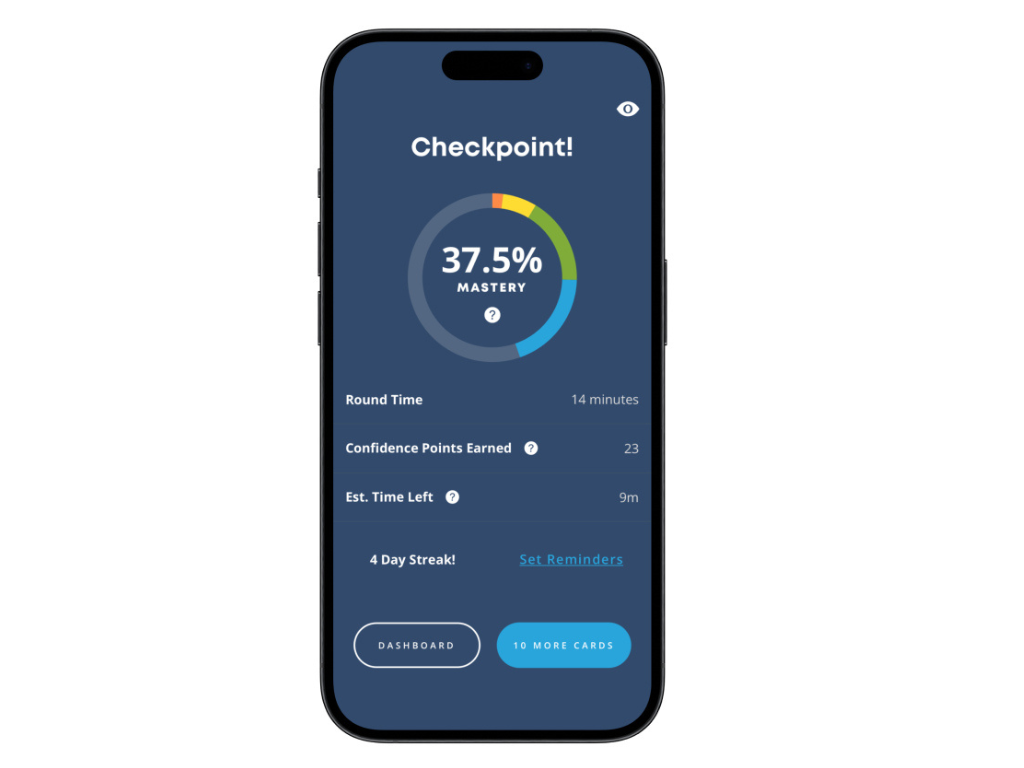
12. Fortified wines
Port, Madeira, Sherry, and fortified Mucats ... for the WSET Level 3 section on fortified wines, you’ll need to know how climate, soils, and topography impact fortified winemaking; the top grapes, production, fermentation, fortification, aging, and maturation methods; and the classifications.
Also, understand:
- How Sherry is made, the difference between biological and oxidative aging, and the solera system (find Brainscape’s deck of WSET 3 flashcards on Sherry here).
- How Port is made and when it is fortified (find Brainscape’s deck of WSET 3 flashcards on Port here).
- How Madeira is made.
- How VDN is made (specifically Fortified Muscats).
- How fortified Muscats are different from Port and Sherry, how all three generally smell and their characteristics.
Check out Brainscape’s WSET 3 flashcard deck on Fortified Muscats & Other Dessert Wines.
With this final section on fortified wines under your belt, you will have covered all the exam topics in the WSET Level 3 and will finally be ready and prepared to do battle with the beast! The final insight we have left to share with you is how the WSET 3 exam is formatted and what you can expect in terms of questions …
WSET 3 exam format and what to expect

The WSET Level 3 exam consists of two units, both of which need to be passed in order to secure you that prestigious WSET 3 pin!
- Unit 1: The Theory of Wines of the World
- Unit 2: The Analytical Tasting of Wine
Unit 1 (The Theory of Wines of the World) is divided into two sections: one with 50 multiple-choice questions, which assess your knowledge and understanding across the subject. The second section consists of short written/essay questions (there are typically four worth 25 marks each).
Unit 2 (The Analytical Tasting of Wine) of the WSET Level 3 tests your ability to taste and evaluate two blind wines, using the Systematic Approach to Tasting (SAT).
A word of advice on the short answer/essay questions
For essay questions, read the question carefully and then begin by brainstorming a structure (along with all the points you’d like to make) in your response. Once you have a cogent argument and structure in mind, start writing. Have an introduction, middle, and end; be clear and concise in your answer; and make sure you actually answer the question.
Be prepared to answer questions that ask you to contrast two different wine regions that grow the same grape. Make sure you discuss everything from soil, climate, and geography, to fermentation, maturation, price, and market.
Pro Tip: Learn your temperatures in degrees Celsius!
A final word on the WSET Level 3 exam
Over the course of your WSET Level 3 studies, you will travel the length and breadth of the vineyard, cellar, industry, and world of wine. And for every minute you spend in awe over some fascinating morsel of information, there will be a day that feels like an endless battle against a crushing tide of facts you need to remember. The WSET Level 3 is a formidable opponent ... but YOU can do this!
With Brainscape's flashcards, you have the ultimate study weapon to take down the beast!
Don't miss our other WSET Level 3 study guides:
- How to study for the WSET Level 3 wine exam more efficiently
- Wine tasting tips for the WSET Level 3 exam
- How to answer WSET short-answer questions
- How to take a WSET Level 3 practice test
P.S. When you're ready to take your next step to WSET Diploma, we have expert-curated flashcards and study guides for all five modules!
*Disclaimer: Brainscape has worked with top wine experts to supplement the official publications and preparation offered by WSET.
